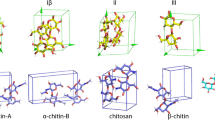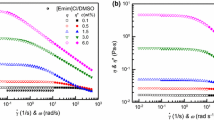Abstract
Small-angle X-ray scattering (SAXS) measurements were carried out for two cellulose tris(phenylcarbamate) (CTPC) samples in tricresyl phosphate (TCP) at 25 °C to determine the particle scattering function P(q) and the z-average mean-square radius of gyration \(\left\langle {S^{2} } \right\rangle_{z}\). The obtained data were analyzed in terms of the wormlike chain model to estimate the Kuhn segment length λ −1 (the stiffness parameter, equivalent to twice the persistence length) and the helix pitch (or helix rise) per residue h. The resultant λ −1 and h were 11.5 ± 0.5 and 0.51 nm, respectively. While the latter value (h) is consistent with the previously reported values both for cellulose and cellulose derivatives, appreciably higher chain flexibility was found for CTPC in TCP than that in tetrahydrofuran at 25 °C (19–24 nm). The value is fairly close to that in anisol, cyclohexanol, and benzophenone, assuming an appropriate temperature coefficient. We may thus conclude that CTPC behaves as a semiflexible chain in TCP.



Similar content being viewed by others
References
Burchard W (2008) Light scattering from polysaccharides as soft materials. In: Borsali R, Pecora R (eds) Soft matter characterization. Springer, Dordrecht, pp 463–603. doi:10.1007/978-1-4020-4465-6_9
Hearon WM, Hiatt GD, Fordyce CR (1943) Carbamates of cellulose and cellulose acetate. I. Preparation. J Am Chem Soc 65(5):829–833. doi:10.1021/ja01245a020
Burchard W (1969) Thermodynamic solution properties of 3 polymers exhibiting lower critical solution temperature. Polymer 10(6):467–475. doi:10.1016/0032-3861(69)90055-x
Burchard W, Husemann E (1961) Eine Vergleichende Strukturanalyse Von Cellulose-Tricarbanilaten Und Amylose-Tricarbanilaten in Losung. Makromol Chem 44:358–387
Burchard W (1965) Uber Die Abweichungen Von Der Idealen Knauelstatistik Bei Amylose- Und Cellulosetricarbanilat in Einem Theta-Losungsmittel. Makromol Chem 88(Oct):11–28
Shanbhag VP, Ohman J (1968) Macromolecular properties of cellulose tricarbanilate in dilute solutions. 4. Unperturbed dimensions of cellulose tricarbanilate from measurements in theta solvents. Arkiv Kemi 29(2):163
Ohman J (1969) A light scattering study of cellulose tricarbanilate in good solvents. Arkiv Kemi 31(2):125–136
Janeschitz-Kriegl H, Burchard W (1968) Flow birefringence of short-chain molecules—cellulose tricarbanilates in benzophenone. J Polym Sci A2 6(12PA):1953–1974. doi:10.1002/pol.1968.160061202
Sutter W, Burchard W (1978) Comparative study of hydrodynamic properties of cellulose and amylose tricarbanilates in dilute solutions—viscosity, sedimentation and diffusion measurements in 1,4-dioxane in molecular-weight range of 500 ≤ M ≤ 5·106. Macromol Chem Chem Phys 179(8):1961–1980
Daňhelka J, Netopilíak M, Bohdanecký M (1987) Solution properties and chain conformation characteristics of cellulose tricarbanilate. J Polym Sci Part B Polym Phys 25(9):1801–1815. doi:10.1002/polb.1987.090250902
Kasabo F, Kanematsu T, Nakagawa T, Sato T, Teramoto A (2000) Solution properties of cellulose tris(phenyl carbamate). 1. Characterization of the conformation and intermolecular interaction. Macromolecules 33(7):2748–2756. doi:10.1021/Ma991443u
Yanagisawa M, Isogai A (2005) SEC-MALS-QELS study on the molecular conformation of cellulose in LiCl/amide solutions. Biomacromolecules 6(3):1258–1265. doi:10.1021/bm049386m
Yanai H, Sato T (2006) Local conformation of the cellulosic chain in solution. Polym J 38(3):226–233. doi:10.1295/polymj.38.226
Yamakawa H, Yoshizaki T (2016) Helical wormlike chains in polymer solutions, 2nd edn. Springer, Berlin
Nakamura Y, Norisuye T (2012) 2.02—Polymer properties in solutions. In: Krzysztof M, Martin M (eds) Polymer science: a comprehensive reference. Elsevier, Amsterdam, pp 5–32. doi:10.1016/B978-0-444-53349-4.00020-0
Norisuye T (1993) Semiflexible polymers in dilute-solution. Prog Polym Sci 18(3):543–584. doi:10.1016/0079-6700(93)90017-7
Koyama R, Sato T (2002) Thermodynamic properties of toluene solutions of low molecular weight polystyrenes over wide ranges of concentration. Macromolecules 35(6):2235–2242. doi:10.1021/Ma011540z
Maeda A, Inoue T, Sato T (2013) Dynamic segment size of the cellulose chain in an ionic liquid. Macromolecules 46(17):7118–7124. doi:10.1021/ma4010764
Jiang XY, Kitamura S, Sato T, Terao K (2017) Chain Dimensions and stiffness of cellulosic and amylosic chains in an ionic liquid: cellulose, amylose, and an amylose carbamate in BmimCl. Macromolecules 50(10):3979–3984. doi:10.1021/acs.macromol.7b00389
Inoue T, Uematsu T, Osaki K (2002) The significance of the rouse segment: its concentration dependence. Macromolecules 35(3):820–826. doi:10.1021/011037m
Kratky O, Porod G (1949) Rontgenuntersuchung Geloster Fadenmolekule. Recl Trav Chim Pays Bas 68(12):1106–1122
Reddy GV, Bohdanecky M (1987) Analysis of the temperature quotient of the intrinsic-viscosity of stiff-chain polymers. Macromolecules 20(6):1393–1396. doi:10.1021/Ma00172a037
Jiang XY, Ryoki A, Terao K (2017) Dimensional and hydrodynamic properties of cellulose tris (alkylcarbamate)s in solution: side chain dependent conformation in tetrahydrofuran. Polymer 112:152–158. doi:10.1016/j.polymer.2017.02.012
Ochiai T, Terao K, Nakamura Y, Yoshikawa C, Sato T (2012) Rigid helical conformation of curdlan tris(phenylcarbamate) in solution. Polymer 53(18):3946–3950. doi:10.1016/j.polymer.2012.07.004
Terao K, Murashima M, Sano Y, Arakawa S, Kitamura S, Norisuye T (2010) Conformational, dimensional, and hydrodynamic properties of amylose tris(n-butylcarbamate) in tetrahydrofuran, methanol, and their mixtures. Macromolecules 43(2):1061–1068. doi:10.1021/Ma902200z
Sano Y, Terao K, Arakawa S, Ohtoh M, Kitamura S, Norisuye T (2010) Solution properties of amylose tris(n-butylcarbamate). Helical and global conformation in alcohols. Polymer 51(18):4243–4248. doi:10.1016/j.polymer.2010.06.048
Terao K, Maeda F, Oyamada K, Ochiai T, Kitamura S, Sato T (2012) Side-chain-dependent helical conformation of amylose alkylcarbamates: amylose tris(ethylcarbamate) and amylose tris(n-hexylcarbamate). J Phys Chem B 116(42):12714–12720. doi:10.1021/jp307998t
Terao K, Fujii T, Tsuda M, Kitamura S, Norisuye T (2009) Solution properties of amylose tris(phenylcarbamate): local conformation and chain stiffness in 1,4-dioxane and 2-ethoxyethanol. Polym J 41(3):201–207. doi:10.1295/polymj.PJ2008233
Fujii T, Terao K, Tsuda M, Kitamura S, Norisuye T (2009) Solvent-dependent conformation of amylose tris(phenylcarbamate) as deduced from scattering and viscosity data. Biopolymers 91(9):729–736. doi:10.1002/bip.21219
Tsuda M, Terao K, Nakamura Y, Kita Y, Kitamura S, Sato T (2010) Solution properties of amylose tris(3,5-dimethylphenylcarbamate) and amylose tris(phenylcarbamate): side group and solvent dependent chain stiffness in methyl acetate, 2-butanone, and 4-methyl-2-pentanone. Macromolecules 43(13):5779–5784. doi:10.1021/ma1006528
Lodge TP, Hermann KC, Landry MR (1986) Coil dimensions of polystyrenes in isorefractive viscous solvents by small-angle neutron-scattering. Macromolecules 19(7):1996–2002. doi:10.1021/Ma00161a036
Berry GC (1966) Thermodynamic and conformational properties of polystyrene. I. Light-scattering studies on dilute solutions of linear polystyrenes. J Chem Phys 44(12):4550–4564. doi:10.1063/1.1726673
Jiang XY, Terao K, Chung WJ, Naito M (2015) Chain dimensions and intermolecular interactions of polysilanes bearing alkyl side groups over the UV thermochromic temperature. Polymer 68:221–226. doi:10.1016/j.polymer.2015.05.018
Nagasaka K, Yoshizaki T, Shimada J, Yamakawa H (1991) More on the scattering function of helical wormlike chains. Macromolecules 24(4):924–931. doi:10.1021/Ma00004a018
Burchard W, Kajiwara K (1970) The statistics of stiff chain molecules. I. The particle scattering factor. Proc R Soc Lond Ser A 316(1525):185–199. doi:10.1098/rspa.1970.0074
Nakamura Y, Norisuye T (2004) Scattering function for wormlike chains with finite thickness. J Polym Sci Part B Polym Phys 42(8):1398–1407. doi:10.1002/polb.20026
Nakamura Y, Norisuye T (2008) Brush-like polymers. In: Borsali R, Pecora R (eds) Soft matter characterization. Springer, Dordrecht, pp 235–286. doi:10.1007/978-1-4020-4465-6_5
Benoit H, Doty P (1953) Light scattering from non-gaussian chains. J Phys Chem 57(9):958–963. doi:10.1021/j150510a025
Konishi T, Yoshizaki T, Saito T, Einaga Y, Yamakawa H (1990) Mean-square radius of gyration of oligostyrenes and polystyrenes in dilute-solutions. Macromolecules 23(1):290–297. doi:10.1021/Ma00203a050
Norisuye T, Tsuboi A, Teramoto A (1996) Remarks on excluded-volume effects in semiflexible polymer solutions. Polym J 28(4):357–361. doi:10.1295/polymj.28.357
Norisuye T, Tsuboi A, Sato T, Teramoto A (1997) Solution properties of cellulose tris(3,5-dimethylphenylcarbamate). Macromol Symp 120:65–76. doi:10.1002/masy.19971200109
Zugenmaier P, Vogt U (1983) Structural investigations on cellulose tricarbanilate: conformation and liquid crystalline behaviour. Macromol Chem 184(8):1749–1760. doi:10.1002/macp.1983.021840818
Asano N, Kitamura S, Terao K (2013) Local conformation and intermolecular interaction of rigid ring polymers are not always the same as the linear analogue: cyclic amylose tris(phenylcarbamate) in theta solvents. J Phys Chem B 117(32):9576–9583. doi:10.1021/jp406607w
Terao K, Morihana N, Ichikawa H (2014) Solution SAXS measurements over a wide temperature range to determine the unperturbed chain dimensions of polystyrene and a cyclic amylose derivative. Polym J 46(3):155–159. doi:10.1038/Pj.2013.76
Acknowledgements
The authors thank Dr. Noboru Ohta (SPring-8) and Dr. Rintaro Takahashi (Kitakyushu Univ.) for SAXS measurements. The synchrotron radiation experiments were performed at the BL40B2 in SPring-8 with the approval of the Japan Synchrotron Radiation Research Institute (JASRI) (Proposal Nos. 2014B1087, 2015A1179, 2015B1100, and 2015B1674). This work was partially supported by JSPS KAKENHI Grant No. 25410130.
Author information
Authors and Affiliations
Corresponding author
Rights and permissions
About this article
Cite this article
Jiang, X., Sato, T. & Terao, K. Chain stiffness of cellulose tris(phenylcarbamate) in tricresyl phosphate (TCP). Polym. Bull. 75, 1265–1273 (2018). https://doi.org/10.1007/s00289-017-2094-z
Received:
Revised:
Accepted:
Published:
Issue Date:
DOI: https://doi.org/10.1007/s00289-017-2094-z




